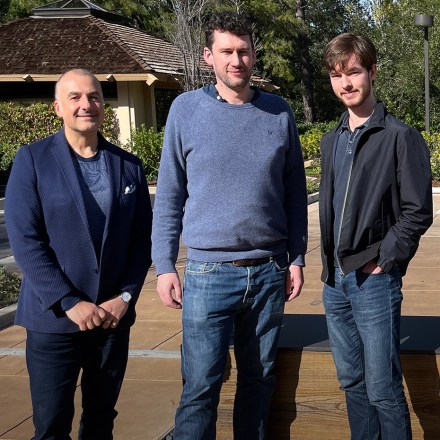At seven years old, Sebastián Ramírez became a Catholic school dropout. Not because he wasn’t engaged, or didn’t care to learn. It was the opposite: According to his teachers, Ramírez was asking too many questions. As was the case for most Catholic schools in Medellín, Colombia, religion was a large component of the education. To the ceaselessly inquisitive Ramírez, faith was fertile ground for interrogation; unfortunately, his teachers did not think the same.
One day, the director of the school called Ramírez’s parents in for a meeting to inform them that he was being difficult. When his parents got home, instead of reprimanding Ramírez, they congratulated him. “You’re doing great,” they told him. “Keep following your curiosity.”
Nearly 30 years later, this same appetite for digging deeper and seeking answers ultimately led Ramírez to create a tool that he hoped would help make software development easier and more efficient. He built a framework called FastAPI that allows developers to create applications quickly and maintain them easily—and it’s open source, meaning that anyone can use or modify it for free. Today, that “anyone” includes everyone from indie developers, to hobbyist coders using Python for the first time, to engineering teams at Uber, Netflix and Microsoft.
But Ramírez’s original ambition for the framework was much simpler: “I made it to please myself,” he says. FastAPI was the software equivalent of an answer to the burning questions he’d been asking himself in different contexts his entire life: Why is this the way it is? How can I make this simpler? How can I make this faster? How can I accomplish more?
How can I make things better, for me and for others?
Shortly after parting ways with Catholic school, Ramírez moved with his family to a modest farm in Santa Elena, a small village about 45 minutes outside of Medellín. His parents had decided that homeschooling was a better fit for Ramírez and his younger sister, Estefania.
The farm in Santa Elena was surrounded by mountains and forests. The family kept a vegetable garden, as well as five Weimaraners, a few cats and two goats, one of which belonged to Ramírez and was his responsibility to wrangle at the end of each day. Ramírez’s parents wanted his education to be holistic, practical and hands-on. In addition to their coursework, Ramírez and Estefania learned how to plant trees, build dog houses and fences and install lightbulbs. This upbringing “fostered a curiosity and interest in how things work,” says Ramírez.
From a young age, Sebastián had a penchant for making everyday tasks more efficient. He recalls at five years old feeling annoyed while assembling a puzzle with his classmates. They would randomly pick up pieces, trying each one until they found a fit. Ramírez proposed that they evenly distribute the pieces among all the children for systematic testing. Mundane chores like washing dishes or feeding the dogs became opportunities for optimization. The impulse, Ramírez says, largely came from a dislike of routine and boredom. It’s “almost like a phobia,” he says. “If I feel I’m doing something simple, mechanical and repetitive, I just want to make it faster, or automate it.”
“If I feel I’m doing something simple, mechanical and repetitive, I just want to make it faster, or automate it.”
Sebastián Ramírez
In 1997, when Ramírez was eight years old, he started helping his parents make sales calls for their business, a consulting company that offered personal development courses for business leaders. By the time he was a teenager, the family business, aptly named Grupo Una Familia, had evolved. They hired themselves out for corporate team-building events, where they combined music, jokes and stories into productions that revolved around a company’s core values. Ramírez threw himself into the music production and graphic design, spending hours in a recording studio with their sound engineer, Chengo, peppering him with dozens of questions as he worked. “He used to call me Spongebob because I would always be ‘absorbing’ as much information as I could,” says Ramírez.
By 15, Ramírez decided that Grupo Una Familia deserved its own website. And given his parents’ lack of tech savvy—they still managed clients on paper and communicated via telephone—he’d be the one to build it. And it wouldn’t just be another GeoCities page; he wanted to build out an entire client management system with photo-uploading functionality and more.
Ramírez’s crash course in web design started with free online tutorials. But before long the instructions started to feel limiting—he didn’t want to just copy and paste code. He wanted to understand the way things worked, and he intuited that there was a whole universe of better tools at his disposal. That’s when he discovered open standards, like HTML, CSS, Javascript and XML, and began devouring them (he taught himself English along the way). The possibilities felt endless.
Studying the standards took time, but Ramírez spent most of his days roaming around the countryside and in the mountains. So he found an old PalmPilot that belonged to his dad and figured out a way to download the standards to the handheld device, hacking together a proto-Kindle of sorts so that he could study wherever and whenever he wanted.
At first, the world of open source—code that’s free for anyone to use and modify—sounded too good to be true: “At that point I didn’t know that 90% of all systems in the world were running on open source,” he says. As he learned more, Ramírez became enamored by the philosophy behind open source—the concept of people helping other people. This was something he had been trying to do all his life, helping his parents, his neighbors and his friends be more efficient in what they do.
Ramírez eventually built the website for his parents. It was as intricate and multi-functional as he had intended. But looking back, Ramírez sees that he failed in one fundamental way: The website wasn’t actually solving the problems that his parents cared about. Using it wasn’t intuitive for them, and it didn’t fit into their workflow. That’s when Ramírez realized that innovation and disruption are not themselves valid raisons d’etre. “They are merely the side effects or results of solving people’s actual problems,” he says.

“At that point I didn’t know that 90% of all systems in the world were running on open source.”
In 2009, when Ramírez was 20 years old, he started experiencing a mysterious pain on his right side. After some scans, the doctors told him he had a cancerous growth the size of a papaya in his chest. Not only that, but the tumor was crushing an entire lung and putting pressure on nearly half of his heart. Ramírez was rushed to the emergency room and started on an aggressive form of chemotherapy. On his 21st birthday, Ramírez asked a nurse to sing him happy birthday while she administered the chemo.
The cancer diagnosis reconfigured Ramírez’s priorities. Up until then, he had continued to work for his parents’ company, but after months of being tired all the time, struggling to eat and drink and really just surviving, he wanted his problems to be “actually important, and to have an impact on something useful for society.”
Shortly after Ramírez finished treatment, his sister introduced him to a new website for online learning called Coursera. After a year of recovering, Ramírez was invigorated by the idea that someone like him in Colombia could take a course from a top university on the other side of the world. He signed up for classes on algorithms, machine learning, cryptography and artificial intelligence, among others—at one point, he was taking eight courses at a time. Without realizing it, the serial autodidact had created his own college curriculum (an overzealous one, he later admits).
Around that time, his brother-in-law asked him to join his machine learning company. Now 23, and despite being armed with a new trove of knowledge from his online courses, Ramírez was reluctant to accept. With no formal education and no college diploma, he says, “I felt a bit lost. I was just some random kid in Colombia.” But ultimately his brother-in-law’s persistence won him over.
To his surprise, Ramírez quickly found his place. As always, he was adept at solving problems and eager to help those around him, and he became a go-to resource for his fellow co-workers for his breadth and depth of knowledge. Before long, Ramírez worked his way up to become the director of software development. It was in this new managerial role that the idea for FastAPI started to germinate. He observed the developers he supervised struggling to write code properly and needing to iterate from scratch for every new project. “I was always trying to come up with better ways to structure code, better tools to use,” he says. As had been his modus operandi since childhood, Ramírez took it upon himself to improve this process.
For the next few years—first in Colombia, and then at a new venture with his brother-in-law in Dubai starting in 2017—Ramírez studied databases, frameworks and various development tools. Each had its strengths, but no single one solved all his problems. Ramírez concluded he had no other choice but to build that tool himself, a realization that brought on a new wave of self-doubt. Despite all of his accomplishments, he still saw himself as “just a nobody from a corner of the world, just a weirdo.” But through his uncertainty, a simple thought persisted: Whatever, I might just try and see what happens.
So Ramírez doubled down on his studies, digging into the structures and connections between relevant web standards, like OpenAPI and the JSON Schema—it was his teenage years redux. Then gradually, Ramírez started building the framework that would become FastAPI.
“I just kept thinking I need to do this. I need to build this.”
Sebastián Ramírez
He was still working for his brother-in-law full-time, with nights and weekends devoted to this passion project. “I was just working like crazy,” he recalled later, so much so that he developed a twitch in his eye, and one of his fingers went completely numb. But maladies and all, an intense excitement unlike anything that he’d ever felt kept him completely focused. “I just kept thinking I need to do this,” he remembers. “I need to build this.”
On Christmas Eve 2018, in what he hoped would be a gift to developers around the world, Ramírez hit publish on the first release of his new framework on GitHub.
Get the best stories from the Sequoia community.
Imagine you’re waiting in a long line at the bank, maybe the DMV—somewhere reeking of bureaucracy. You fill out a long form while you wait, but halfway through you realize you’ve made a mistake and have to start all over again. When it’s finally your turn, the clerk behind the desk is sleepy and distracted as they check your form—by hand, of course. Ramírez says that this is what building software typically feels like: It’s inefficient, laborious and easy to make mistakes.
Ramírez created FastAPI to simplify and streamline that process. “In FastAPI, you probably wouldn’t be standing in line,” he says. “You would be sitting with a ticket number, the line would go much faster, and the person helping you would be very supportive and attentive. And the form that you’d have to fill out would be very clear.”
This is the analogy that Ramírez uses to explain FastAPI to his parents (and to anyone who needs to Google what API stands for—application programming interface). In essence, it’s a faster, simpler framework for building APIs using Python, the most popular programming language for data science, machine learning and artificial intelligence applications.
Before FastAPI, most of the existing Python frameworks for building software applications were created in the language’s earliest days, before Python introduced a series of new features including “async and await,” which reduced the computing power needed to run an application, and “type annotations,” which enabled code auto-completion. FastAPI leveraged these and other advancements to create a more streamlined developer experience.
Unlike with his parents’ website, this time Ramírez was the end user. He created FastAPI to address the issues that most irked him in his years of building cloud software, prioritizing features of code editors like auto-completion, and in-line error notifications to reduce the amount of text developers need to write and to help them identify bugs before deploying their code.
“I wanted things to be explained the way I wished they were explained to me when I was starting.”
Sebastián Ramírez
Typically, technical documentation for tools like FastAPI is sparse, opaque and excruciatingly technical, putting the burden on the individual developer to figure things out. But in a nod to his days learning English from open-source protocols, Ramírez made sure to include extensive documentation for his tool—an in-depth instruction manual for how to use, develop and deploy the framework. “I wanted to explain all the concepts that were necessary, even if they weren’t strictly related to FastAPI itself, because I wanted to teach people everything they needed to know to be able to use FastAPI,” says Ramírez. He even hired a designer to create graphics to help explain some of the tool’s more complex aspects. FastAPI would be intelligible to anyone, even someone in a rural corner of the world without easy access to a technical education who might benefit from a little extra explanation. “I wanted things to be explained the way I wished they were explained to me when I was starting,” he says, recalling an idea once articulated by Guido van Rossum, the inventor of Python: that you primarily write code to communicate with other coders.
Ramírez’s efforts to make FastAPI accessible and effective have paid off. The technology underpins tools for galaxy simulations and drug discovery, Red Cross disaster management and COVID tracking, human resources management and quantum cloud services, airplane manufacturing and self-driving car applications. Its users include established tech giants like Microsoft, Google and Netflix, as well as early-stage startups. Even the Space Telescope Science Institute, which handles the Webb Space Telescope, uses FastAPI to speed up access to their scientific data. As of 2023, FastAPI is downloaded roughly 800,000 times per day.
Sequoia partner Lauren Reeder says, “We heard about FastAPI everywhere, from our biggest portfolio companies like Rippling to weekend hackathons. It really spans the gamut.” When she and fellow partner Bogomil Balkansky were thinking about starting a Sequoia Open Source Fellowship, Ramírez was the first name that came to mind. In January 2023, they invited him to be the program’s first fellow.
The fellowship means that, for the first time in his life, Ramirez can focus full-time on his open-source work. At the moment this includes completing an integration with Pydantic v2 (rewritten in Rust for added performance benefits and reduced energy consumption), building in Typer, SQLModel and Asyncer functionality, and writing even more robust documentation for his system. These individual improvements ultimately serve his greater purpose of “building tools that help others build things as easily as possible and that benefit their communities and society in general,” he says. “I want to improve, and keep improving that.”
Shortly after he first learned about algorithms, Ramírez walked into his mom’s office one day to find her surrounded by stacks of paper. She was at a loss, attempting to sort the hundreds, if not thousands, of sheets alphabetically. Ramírez realized at that moment that the principles behind algorithms didn’t only apply to digital realms; here was his opportunity to use them in the physical world. He decided to help his mom using an analog “merge sort” algorithm, first sorting the papers into smaller, less overwhelming stacks and categorizing those before eventually merging them back into a final pile.
“It was strange for my mom,” he recalls, “but she followed along.” He timed the entire process from start to finish. Within 30 minutes, the papers were stacked in one neat, alphabetized bundle. “At that moment I felt that the things I was learning were very powerful in unexpected ways,” he says. The power lay in being able to create something that helps people achieve their goals, which is the very thing that Ramírez has accomplished with FastAPI. “When you build something that others can use and it’s helping them, that just feels amazing, you know?” says the 34-year-old with a smile. “That’s just the best feeling.”



